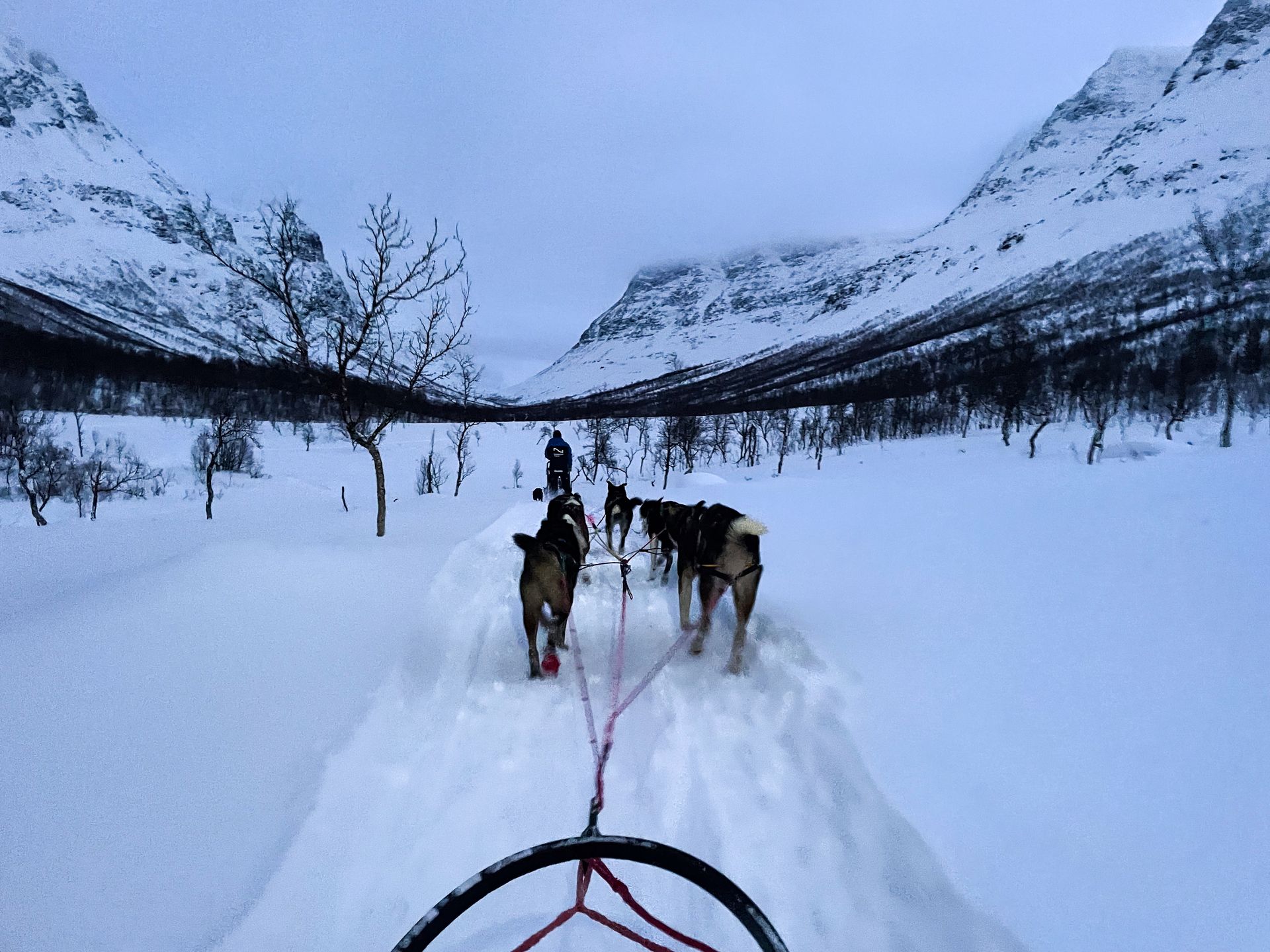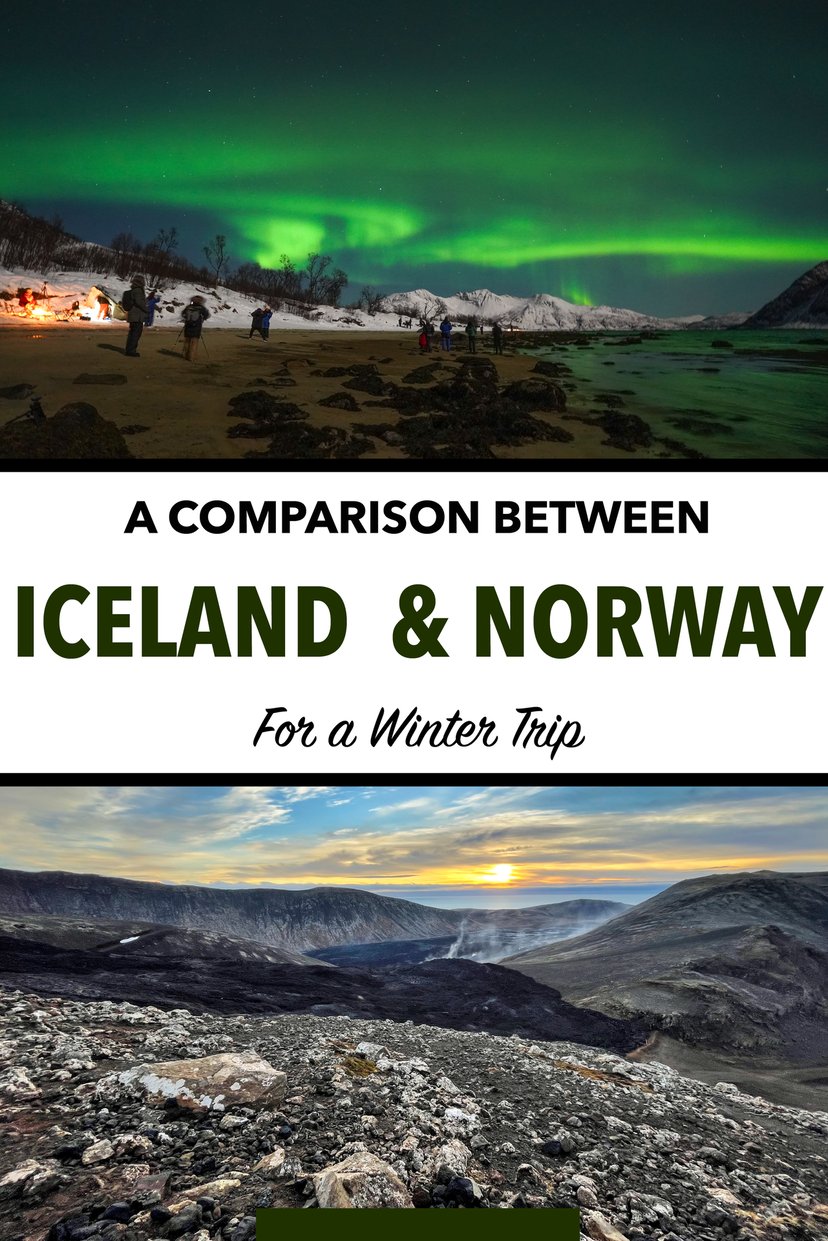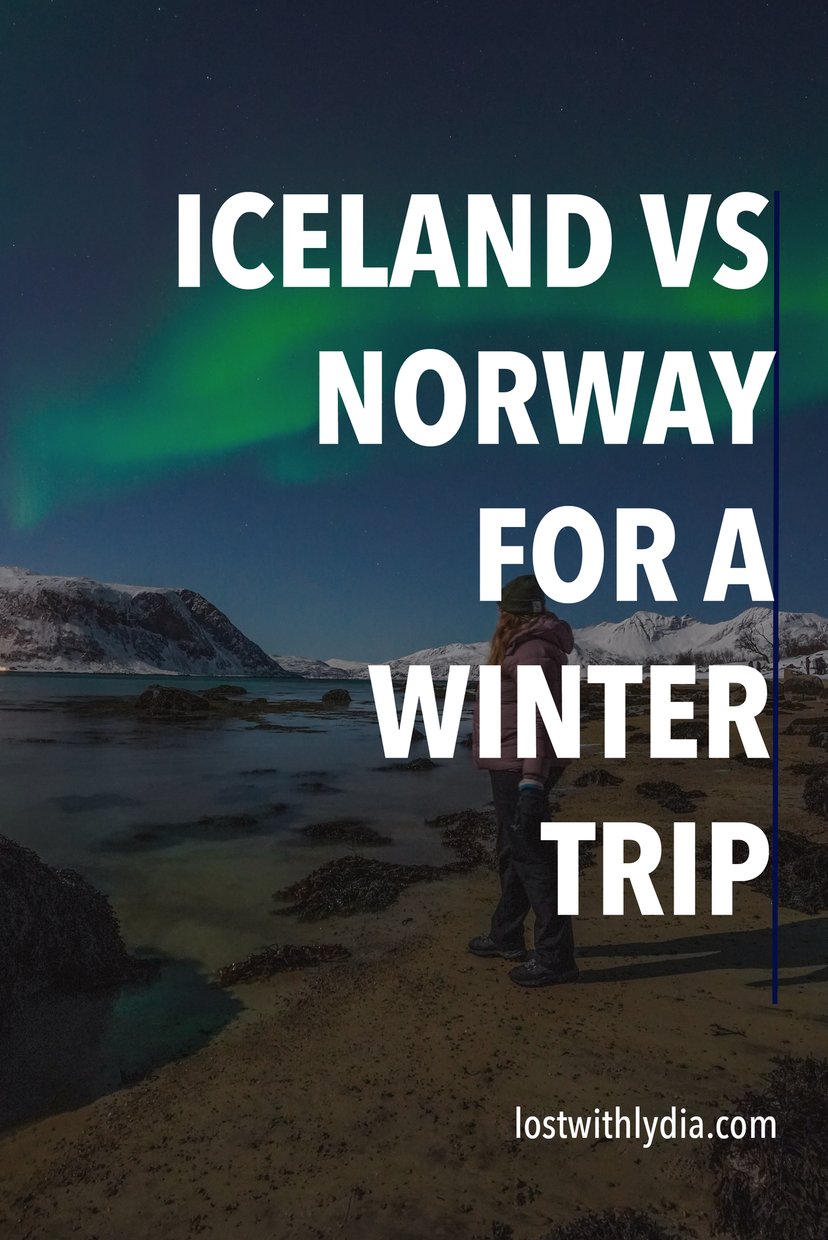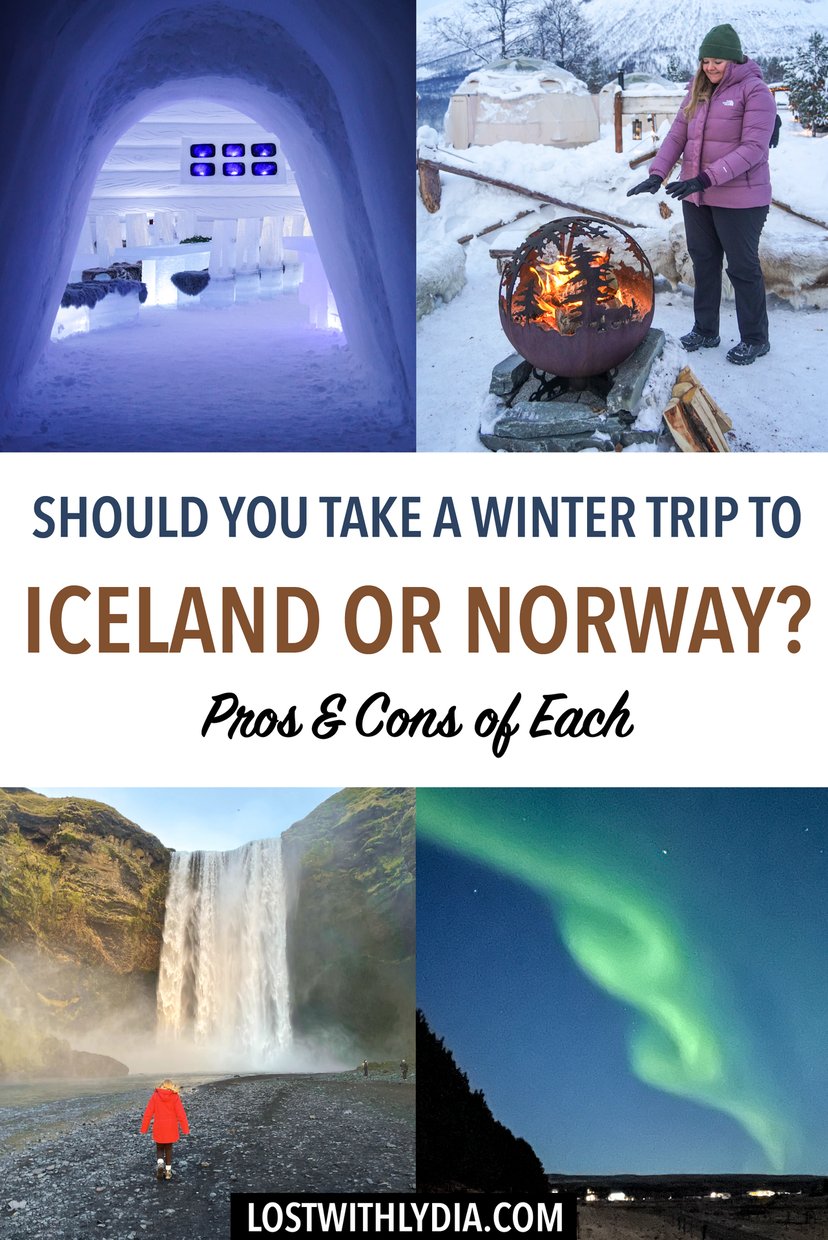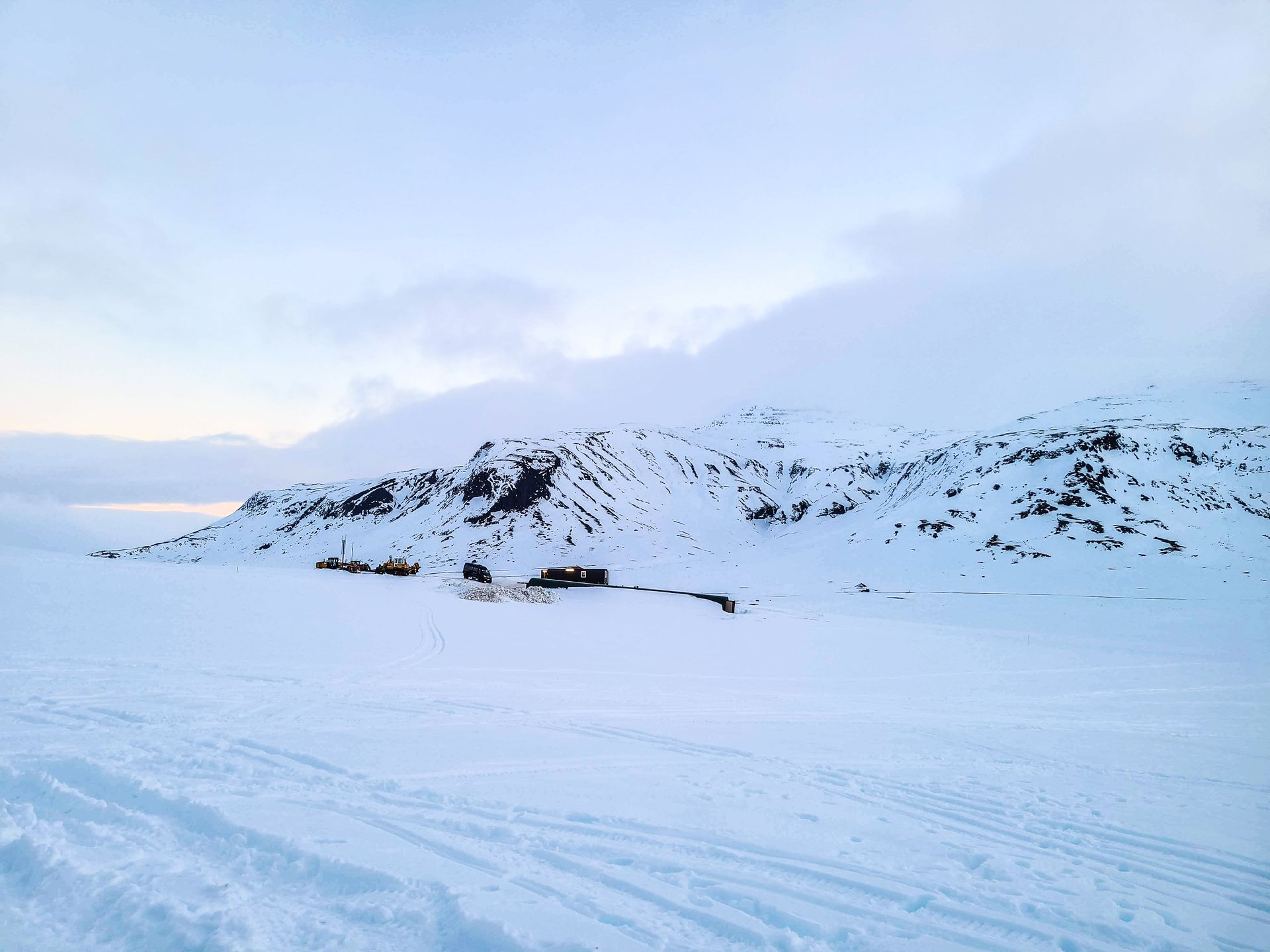Are you dreaming of a winter getaway with activities like snowmobiling, winter hiking, chasing the Northern Lights and more? Both Iceland and Norway make for incredible trips!
If you’re wondering which country to visit for a bucket list trip, keep reading to learn about my experience visiting both Iceland and Norway in the winter.
An Overview of Winter Travel to Norway vs Iceland
Winter in Norway
Norway is much larger than Iceland (over 3 times as big by land mass and about 14 times bigger by population). When it comes to spending a bucket list winter trip in Norway, I recommend traveling into the Arctic Circle in the Northern part of the country.

A trip to Tromsø makes for an incredible getaway. It’s known as the “Paris of the North” and is the perfect base to chase the Northern Lights, experience the Polar Night and take part in activities such as reindeer sledding, snowshoeing and more.
Because Norway is so large, you’ll have a very different experience on a winter trip to Oslo (Norway’s capital city, located in the Southern part of the country) or a winter trip to Tromsø. For the purposes of this comparison, I’ll be mostly talking about taking a winter trip to Tromsø.
Tromsø receives zero hours of daylight from the end of November to mid-January. Average temperatures in January, the coldest month of the year, range from 21°F to 29°F (-6°C to -1°C).
Snow can vary year to year, but Tromsø tends to have an average of 16.2 inches of snow in January. This is about twice the amount of snow that Reykjavík receives in January. So if you’re looking for a white Christmas, you’re more likely to see that in Tromsø.
Here are a few of the best things to do on a winter trip to Tromsø, Norway:
- Stay in an ice hotel at the Tromsø Ice Domes
- Go snowshoeing
- Go dog sledding
- Visit a Sami Family
- Explore the museums and restaurants in town
- Go whale watching
- Chase the Northern Lights
Winter in Iceland
Iceland is a land of extremes. Characterized by both fire and ice, this remote island is known for both glaciers and volcanoes. During a winter trip to Iceland, you might find yourself soaking in hot springs, visiting black sand beaches, hiking up volcanoes, touring an ice cave, and more.
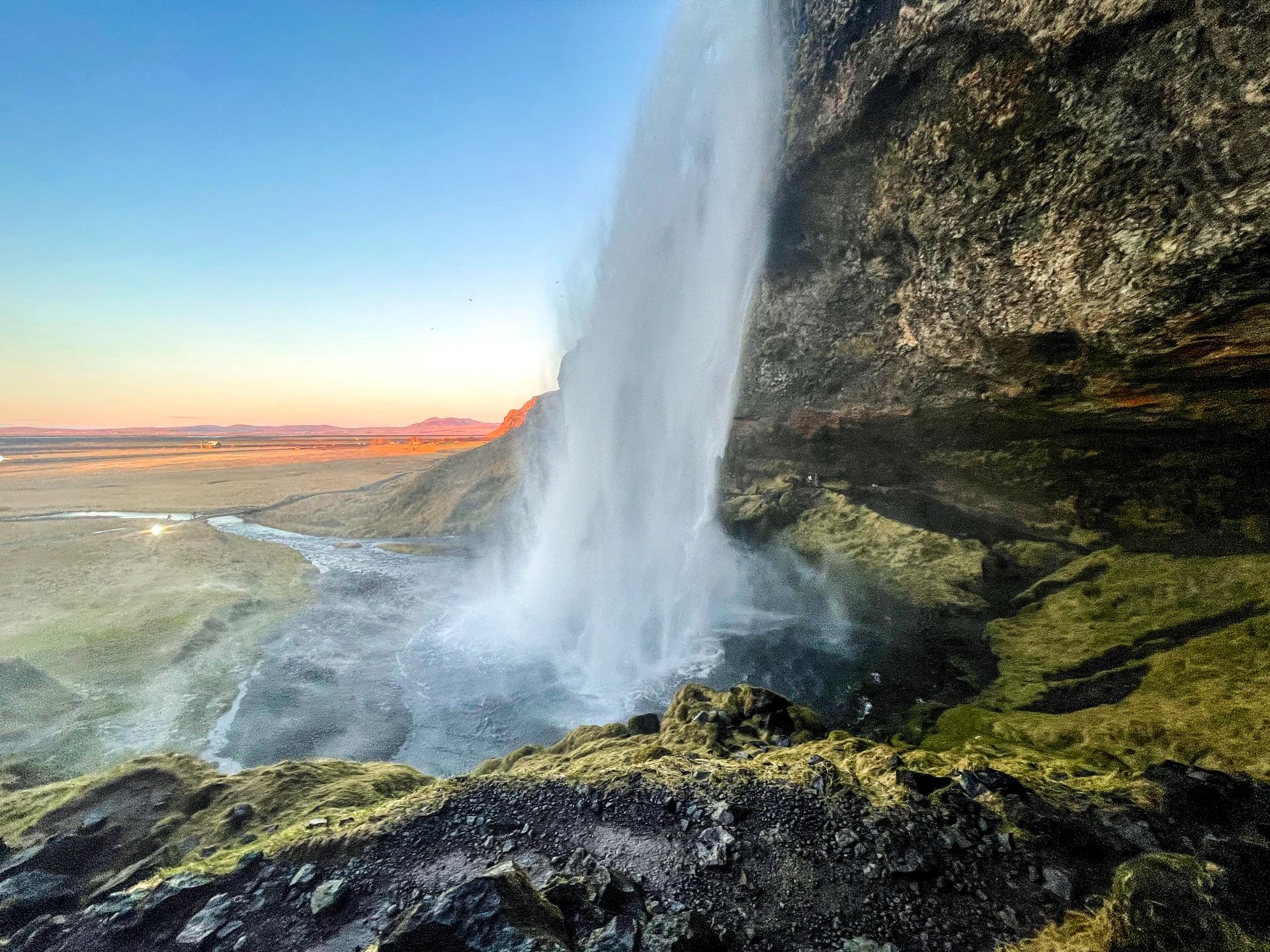
If you’re considering a winter trip to Iceland, I recommend renting a car and exploring many of the same areas that you might visit during the summer. Some of the best things to do in Iceland include visiting Vatnajokull (the largest glacier in Europe), enjoying waterfalls (such as Gullfoss, Skógafoss and Seljalandsfoss), snorkeling between tectonic plates at Thingvellir National Park and visiting the Blue Lagoon.
Iceland receives very little daylight in the winter, but it does receive some. There are 4-5 hours of daylight in December and 4-6 hours in January. The coldest month of the year is January, when there is an average low of 26.6F° (-3 C°) and an average high of 37.4F° (3 C°). These darker months are the best time of year to see the Northern Lights.
The capital city of Reykjavík receives about 9.7 inches of snow in January. As you can see, Iceland tends to be warmer and has less snow than Tromsø. It also receives more daylight through the winter. This makes sense since Iceland is further from the North Pole than Tromsø.
Here are a few of the best things to do on a winter trip to Iceland:
- Soak in a hot spring
- Go hiking
- Road trip to iconic sites such as Geysir, Reynisfjara and Skógafoss
- Take a snowmobile tour and explore an ice cave
- Go snorkeling between tectonic plates
- Chase the northern lights
A Comparison Between Norway and Iceland
Population:
Iceland: 395,027
Norway: 5,592,235
Land Mass:
Iceland: 103,125 km2 (39,817 sq mi)
Norway: 324,220 km2 (125,180 sq mi)


Which country has more daylight hours in the winter? Iceland
Tromsø has a long period of time where there are zero hours of daylight in the winter, while Iceland always has at least 4 hours of daylight.
Which country is colder in the winter? Norway (in Tromsø)
Tromsø tends to be about 5-8 degrees colder than Reykjavík in the winter. However, this can really vary. Iceland can be extremely windy, which of course can contribute to it feeling colder. For both countries, you’ll want plenty of warm layers for a winter trip.
Read my packing lists for winter trips to Iceland and Norway
In which country are you more likely to see the Northern Lights? Norway (in Tromsø)
Because Tromso is located further north, you have a better chance of seeing the Northern Lights there. However, I saw them in both countries!
Which country is more expensive? Iceland
The cost of living tends to be higher in Iceland. According to Numbeo, the cost of living in Iceland is 24.6% higher than in the United States, while the cost of living in Norway is 8.6% higher than in the United States. Both countries can be quite expensive to travel to, but it really depends on what activities you partake in, where you eat, where you stay, etc. Personally, I spent more on my trip to Norway than to Iceland due to the activities I did.
Which country has more volcanic activity? Iceland
Iceland has more volcanic activity than Norway. Norway does have some volcanoes - there 2 active volcanoes and 38 total. However, Iceland has 130 volcanoes and 30-40 that are active. You might recall seeing and hearing about volcanic eruptions in Iceland in recent years.
Which country is older (in terms of human activity)? Norway
Norway dates back much further when it comes to the earliest recorded human activity. People started settling in Norway in 9000 BC and in Iceland in 874 (although there is some evidence it was earlier). Also, Norway became a country in 1905 and Iceland became a country in 1944.
Similarities Between Iceland and Norway


-
Both countries are full of outdoor adventures and incredibly beautiful! Activities like hiking, snowshoeing, and sightseeing are amazing in both countries.
-
You can draw connections in both countries to the Vikings. The Vikings hailed from Scandinavian countries, such as Norway. And the vast majority of Icelanders can trace their ancestry back to Viking settlers.
-
Both Norway and Iceland are in Europe, but they are not a part of the European Union. However, they are both part of the Schengen Area, meaning that people can travel freely between them.
-
Both countries have North Germanic languages. In Iceland, they speak Icelandic. In Norway, they speak Norwegian.
Is Norway or Iceland better for a winter trip?
Now for the big question, which country do I recommend for a winter trip?
Well, I certainly recommend both. Both countries are incredibly beautiful and this really depends on your particular goals. However, when it comes to a quintessential winter trip that includes seeing snow, the Northern lights and perhaps enjoying activities such as sleeping in an ice hotel, dog sledding and more, I have to recommend Tromsø, Norway.
Iceland makes for an incredible road trip and adventurous trip, but I’m looking forward to a future visit in another season so that I can spend more daylight hours hiking and exploring. However, I felt that Tromsø was full of winter magic and I had an amazing time embracing the darkness in the winter months.
I recommend Tromsø for that magical winter getaway, but I really enjoyed both trips and don’t think you can go wrong either way.
Another country that makes for a magical winter trip? Finland! (in the Lapland Region). Check out this guide for more details.
Final Thoughts
I hope this guide helps you make a decision on whether to travel to Norway or Iceland in the winter! Both countries are incredibly beautiful and full of rugged, outdoor adventures that can be enjoyed year round.
Keep planning your trip with these guides to Norway and Iceland:
- A Guide to Winter Trip to Tromso
- How to Spend One Day in Oslo, Norway
- What to Pack for Tromso in the Winter
- A Review of the Tromso Ice Domes
- The Perfect Iceland Winter Itinerary
- A Guide to Renting a Car in Iceland
- What to Pack for a Winter Trip to Iceland
Thanks for Reading!
Let's stay in touch!
Join the Lost with Lydia email list to get monthly travel guides and tips!
